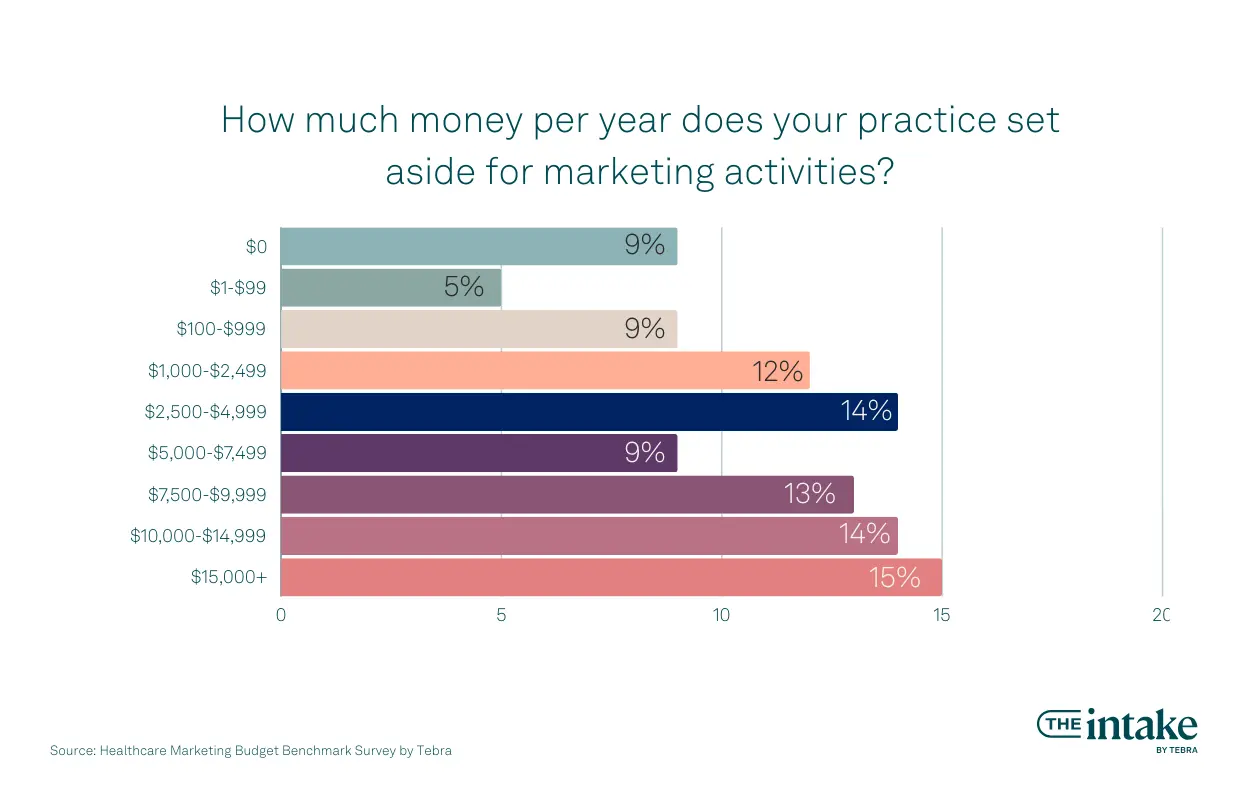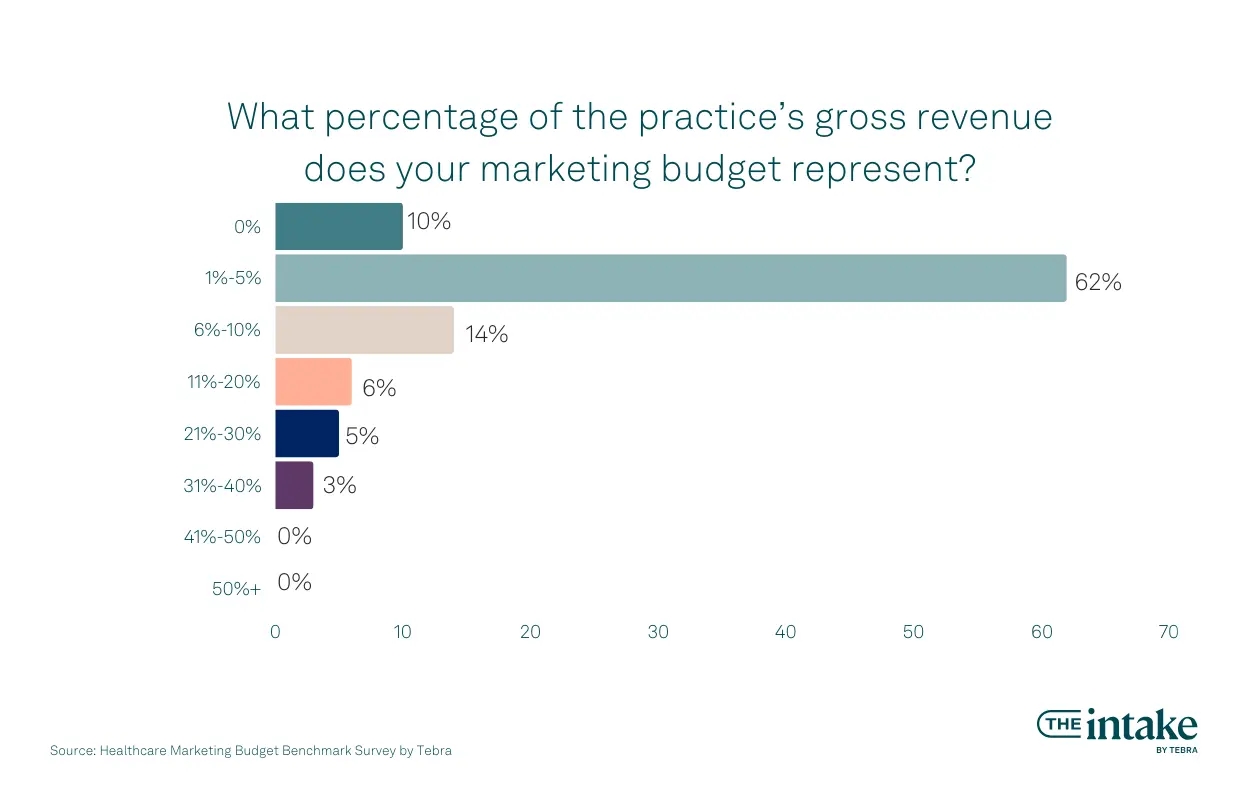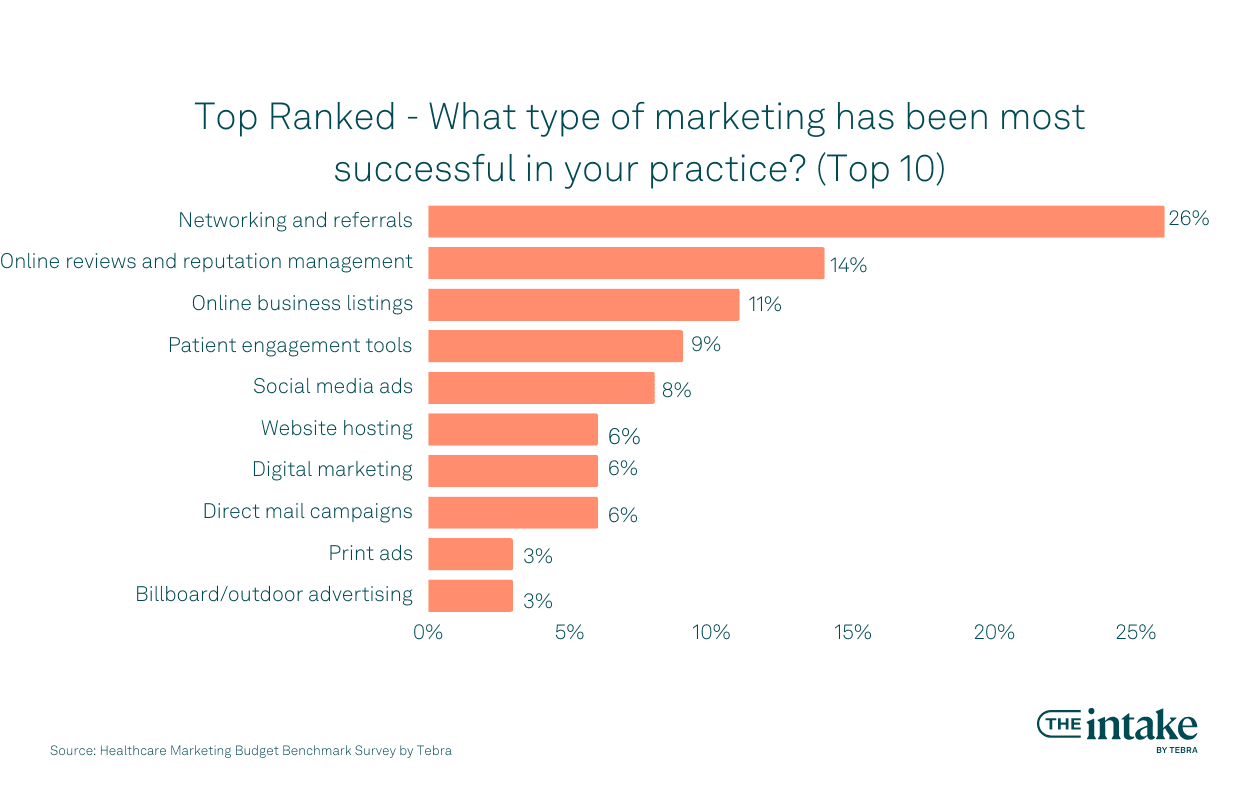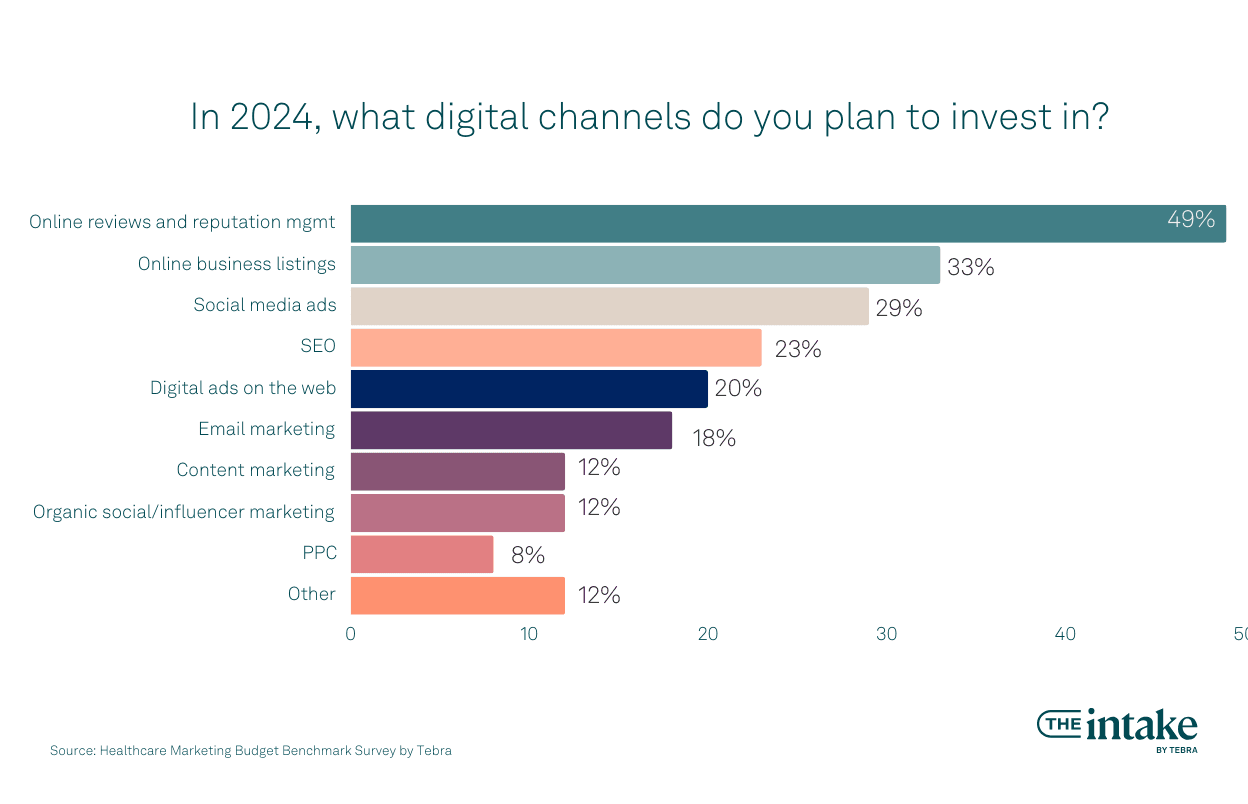
- Most practices dedicate 1–5% of revenue to marketing, though new or growth-focused practices often need to invest more.
- Digital tactics such as SEO, online listings, and reputation management typically outperform print or billboard ads in ROI.
- Budget flexibility matters — build in room for experiments (e.g., LLM search or GEO optimization) and unexpected costs.
- Patient retention channels (text/email recall, portals) deserve just as much budget consideration as patient acquisition.
A marketing budget isn’t optional for medical practices, it’s the foundation for attracting new patients in your community, strengthening retention, and allocating resources wisely. Most practices invest 1–5% of revenue in marketing, but the right amount depends on your growth stage, local competition, and long-term goals.
In competitive markets, digital strategies like local SEO, targeted social ads, and online reputation management deliver the strongest ROI by connecting you with nearby patients searching for care. A flexible, well-structured budget ensures you can adapt to changing patient expectations and regional healthcare trends.
In an ideal world, your service would be your marketing.
But the reality is that you need to market your healthcare practice to attract and keep patients.
You’ve probably dabbled in marketing. Maybe you’ve tried your hand at Meta advertising, social media marketing, or even blog posts. While the first step to getting started is… getting started, deciding on your marketing budget is high on the priority list.
Whether you outsource or handle your marketing in-house, you’ll have to determine your medical practice’s marketing budget. How much should you spend to get patients in the door?
Of course, there’s no one right answer. (Nothing’s ever that easy.) But we’re here to help you determine:
- The average medical practice marketing budget
- The factors you should use to come up with your own
- The percentages of your marketing budget you should spend on a variety of tactics
In the Healthcare Marketing Budget Benchmark Survey, Tebra surveyed owners and managers of 106 private practices to hear how they allocate their marketing budgets directly from them.
Download your free resource now
Access it instantly — just complete the form

Why a medical practice needs a marketing budget
Attracting new patients requires a different approach than effective patient recall. A medical practice marketing strategy should be able to cater to patients at different stages of the sales funnel — and a marketing budget is a key part. Here are a few reasons why a marketing budget is an important part of practice growth:
- Practice visibility in a competitive market: A marketing budget allows a practice to promote its services and providers. This visibility is part of attracting new patients and retaining current ones.
- Strategic resource allocation: A clear budget means clarity around spending limits. Rather than on-the-fly decision making, the practice will already know how much money is available for a given channel, support team, or test. It also prevents under- or overspending, leading to a balanced marketing plan.
- Track return on investment (ROI): ROI is an important part of success. A marketing budget is a template for investment tracking that can help in ongoing evaluation and can inform future decisions.
- Prepare for long-term growth: Marketing is an important investment. Successful marketing efforts can allow a practice to build a strong foundation, hit existing targets, and even plan for expansion. A good marketing budget supports practice visibility, reputation, and growth.
- Easy adaptation and decision-making: The healthcare industry and digital landscape are in flux. Having a clear marketing budget allows a practice to adjust and respond to changes where necessary during the year, without breaking the bank.
In sum, a marketing budget for an independent medical practice is not just about attracting more patients. It’s a multifaceted strategy that supports visibility, growth, evaluation, adaptability, and financial stability. These elements collectively enhance the practice’s ability to provide quality care while maintaining success as a business.
How much do private practices spend on marketing?
According to Tebra’s survey, here’s roughly how much private medical practices spend on marketing in dollars:
- ⅓ spend less than $2,500
- ⅓ spend $2,500 to $10,000
- ⅓ spend over $10,000
Here’s the full budget breakdown:

However, if you’re looking for an easier way to calculate your own budget, it’s more helpful to look at the marketing budget as a percentage of the practice’s overall revenue:
- 10% of practices spend 0% of their revenue on marketing
- 62% spend 1 – 5% of revenue on marketing
- 14% spend 6 – 10% of revenue on marketing
- 14% spend 11 – 40% of revenue on marketing

How should you determine your healthcare marketing budget?
Several critical factors play into how you determine your annual healthcare marketing budget. It’s not just about picking a number that sounds good — it’s about strategically aligning your financial resources with the unique aspects of your practice.
Consider these factors when determining your healthcare practice’s marketing budget.
- Your revenue: Start here. While having a dollar amount in mind for your budget is fine, it makes the most sense to base it on a percentage of revenue. In Tebra’s survey, 62% of practices have a marketing budget between 1 and 5% of their revenue.
- Whether you’re a new or existing practice: Getting started is a tough marketing place to be in. If your medical practice is brand new or you just opened a new office, you’re starting from scratch. You won’t have any brand awareness or existing tactics like referrals and reviews to lean on. Practices at this stage have to allocate a much higher percentage of their revenue for marketing efforts than practices that have been around for a while. You’ll have to balance the need for new patients with your available funds.
- Your goals and growth rate: What are your expectations for growth? If you’re doubling down on marketing in hopes of doubling the size of your practice in a year, then a 5% marketing allocation won’t cut it. Increase or reduce your marketing budget based on whether you’re hoping for drastic growth or want to grow at a more natural pace. Also, take a look at your patient capacity. If you can’t expand your care team, how many patients can you realistically see in a day? If you’re well under capacity, it means you need to siphon more money into your budget. However, you can have a more conservative marketing cap if you're near max capacity.
- Your specialty: How competitive is your industry? Scope out your direct competitors to get an idea of how much time and energy they spend on their marketing, and let that influence your budget. For example, the marketing landscape is much more competitive if you’re a plastic surgeon or a dermatologist. You’ll likely have to spend more to stand out in a crowded market.
“If you can’t expand your care team, how many patients can you realistically see in a day?”
Your specialty also impacts your patient lifetime value. Do you often see patients for a short period of time, like a physical therapy clinic? Then, you need to work harder to continue to acquire new patients. However, if you work in primary care, your patients will typically stick around longer, and you won’t have to continuously work as hard to find new ones.
- Your location: Consider your location's population size and whether or not you have a lot of competition nearby. Metropolitan areas may have more people to advertise to, but they also have more competition. In contrast, an urgent care in a rural area with no nearby competitors may not need a high marketing budget.
- Your number of team members. A practice can have massive growth or retention plans, but these plans will fall flat without the resources to execute them. Does the practice have in-house marketing expertise? Or does the team need to train and bring new hires up to speed? If the practice has the expertise but no staff member or bandwidth to execute the strategy, hire freelancers. If the practice has neither, work with an agency with experience in the healthcare industry.
- Team resources for marketing. Marketing keeps changing. If the practice team is not prepared to tackle these challenges, its effort might go to waste sooner rather than later. It's best to set aside some money for self-paced courses or workshops. Doing so will provide a much better ROI for the practice as the team will be equipped with new tactics that could grow the business.
What should a medical practice marketing budget include?
A well-structured marketing budget is essential to get your marketing plan up and running. But what should medical practices put in a marketing budget? Consider these elements:
- Advertising spend: Probably the most obvious number to track is the money you’ll spend deploying ads. This should include the cost of social media ads, pay-per-click advertising, print ads, billboards, etc.
- Content creation: Budget for creating high-quality, engaging content for your website, blogs, and social media channels. This might include costs for copywriting, video production, and graphic design.
- Digital tools and software: Include funds for essential digital marketing tools and software. This may cover email marketing services, social media management tools, patient engagement platforms, and more.
- Website maintenance and SEO: Allocate funds for ongoing website maintenance, hosting fees, and search engine optimization (SEO) to ensure your practice continues to attract potential patients online.
- Agency fees: While not mandatory, investing in a reputable healthcare marketing agency can be a strategic move. Their expertise not only saves you time but can save money with their dialed-in marketing tactics.
- Staff costs: Staff fees often aren’t included in healthcare marketing budgets because it’s difficult to track, and administrative staff frequently complete marketing activities between their many other duties. Yet, it’s critical to get an accurate idea of how much each marketing tactic costs you and whether it’s worth the return on investment (ROI).
How to allocate your annual marketing budget
Once you’ve decided on your marketing budget, you need to determine how to spend it. You need a strategic approach that balances multiple channels to achieve the highest ROI. Let’s examine marketing tactics and how medical practices allocate their budgets.
Note: You can also start with a goal-based marketing budget that works through this process backward. Start with your goal, determine the tactics to get there, and set the budget based on that information.

Networking and referrals
Average budget:
- 41% of practices spend $1 to $999 annually on networking and referrals
- 35% spend more than $1,000 a year
- 24% spend nothing
Networking and referrals are often the most effective marketing tactics that medical practices can employ. However, they're not often reflected accurately in marketing budgets.
These often include hard expenses like health fairs, networking events, and conferences. It pays for tickets, signage, promotional items, and booth fees.
“You need to deliver consistent results, have strong patient relationships, offer personalized care, and keep patients engaged.”
However, this doesn’t account for the intangibles that make networking and referrals effective. It takes time to build relationships and earn a reputation that encourages people to recommend your practice. You need to deliver consistent results, have strong patient relationships, offer personalized care, and keep patients engaged.
Networking is a great marketing tool for longevity and sustainable growth, but it’s not a quick solution for attracting more patients to your practice.
Online business listings
Average budget:
- 46% of medical practices allocate between $1 and $999 annually to online business listings
- 40% spend more than $1,000 a year
- 14% spend nothing
As part of your marketing budget, allocate resources to ensure your practice is accurately and prominently listed across various online platforms. Online listings, such as Google Business Profile (formerly Google My Business), insurance websites, and review sites improve your SEO, making you more likely to land on top of the results page.
That’s likely why 42% of surveyed medical practices use online business listings. It’s ranked the #2 most used tactic and the second most successful for practices. Yet, most providers only keep up with 1 to 3 listings out of more than 60 in the market.
“To make the most of your online listings, you need to claim them and update them monthly to reflect new information.”
To make the most of your online listings, you need to claim them and update them monthly to reflect new information (think: updated hours, new providers, additional specialties, etc.). Overall, practices said managing their online listings was the third most effective marketing tactic.
Whether you manage your own online listings or automate them, it drastically impacts your searchability on the web and offers a high ROI.
Download your free resource now
Access it instantly — just complete the form

Online reviews and reputation management
Average budget:
- 38% of medical practices allocate between $1 and $999 annually to online reviews and reputation management
- 32% spend between $1,000 and $2,499 a year
- 19% spend more than $2,500 a year
- 11% spend nothing
Managing your healthcare practice’s online reputation is critical in today’s digital landscape. According to Tebra’s 4th annual Patient Perspectives report, 3 in 4 patients say online reviews are extremely or very important when choosing a healthcare provider.
According to Tebra’s most recent survey, 37% of medical practices use online reviews and reputation management as part of their marketing efforts, and practices ranked it the second most successful marketing tactic overall.
You can manage reviews, send surveys, monitor feedback, and respond to reviews either with your in-house team or through reputation management automation.
Take a look at some additional strategies to boost your online reputation.
Social media ads
Average budget:
- 43% of surveyed medical practices spend between $100 and $990 annually on social media ads
- 25% spend between $1,000 and $2,499 annually
- 32% spend more than $2,500 annually
Medical practices can use social media ads to attract new patients and engage current ones. Ads offer a strategic way to increase visibility and promote health services.
Social media advertising enables practices to target specific demographics, tailoring messaging to potential patients based on age, location, interests, and even health-related behaviors. This level of customization ensures that you use your marketing dollars efficiently and helps you reach the right audience with the right message.
“Social media advertising enables practices to target specific demographics, tailoring messaging to potential patients based on age, location, interests, and even health-related behaviors.”
Given how budget allocations vary, there’s clearly flexibility in how much you invest in this channel. The key is to align your spending with clear objectives and measurable outcomes. This could include increasing website traffic, boosting appointment bookings, or enhancing patient engagement.
Earned and owned digital media
Average budget:
- 33% of surveyed practices spend between $1 and $999 annually on SEO, while 7% spend between $7,500 and $9,999, and 40% spend nothing.
- 40% of practices spend between $1,000 and $2,499 on digital marketing, and 35% spend over $2,500.
- 42% spend between $1 and $999 on content marketing, and 41% spend between $1,000 and $2,499.
Earned media is any content written about your business that you didn’t pay for or create yourself. Owned media are tactics like your practice website, blog, or social media accounts. Together, they make a powerful marketing platform.
Search engine optimization (SEO) falls somewhere in the middle, influenced by what you write about your practice and what others write about it. With average budgets indicating modest SEO spending for most medical practices, you can do the most by optimizing your existing website and using local SEO strategies.
“Since creating a practice website or starting a blog can seem daunting, many practices outsource it to healthcare marketing agencies.”
Since creating a practice website or starting a blog can seem daunting, many practices outsource it to healthcare marketing agencies with the resources to build a full digital marketing strategy.
Whichever budget range you determine will also likely determine the depth of your strategies. SEO and content marketing are both long-term strategies that take time to build up but pay off in the end.
Print advertisements and billboards
Average budget:
- Print advertising
- 33% of private practices spend between $1 and $999 annually
- 30% spend between $1,000 and $2,499 annually
- 37% spend more than $2,500 annually
- Billboards and outdoor advertising:
- 33% of private practices spend between $1 and $999 annually
- 42% spend between $1,000 and $2,499 annually
- 25% spend more than $2,500 annually
Print ads and billboards require relatively minimal expertise and are a straightforward option for medical practice marketing. They’re both easy to create, either by an in-house team or through an agency, and reusable for multiple campaigns.
While it’s hard to measure the ROI of billboards, coming in last place on Tebra’s most impactful survey, this traditional approach can work in high-traffic areas. Billboards may cost as little as $2,000 per month but can soar to as much as $100,000 in populous urban areas. Still, they should be considered for brand awareness and patient acquisition.
Print ads come with a much smaller price tag, with magazine ads typically starting around $500. Still, those considering print ads should take a closer look at digital ads for their ability to target specific demographics and their trackability.
Mistakes to avoid while creating a healthcare marketing budget
It’s normal to get tunnel vision and fall into a few traps while building a practice marketing budget. Here’s a list of issues to avoid.
1. Not creating a buffer for each budget category
While the overall budget is fixed, the categorical budget should be flexible. Unexpected costs arise at all times. For example, it might be necessary to pivot to a different marketing strategy or deal with increasing advertising rates.
Without a buffer, chances could strain the budget and force the practice to redirect funds into the needed areas. Instead, add a small buffer for unforeseen expenses to keep up with internal changes.
2. Not allocating resources for growth experiments
As channels emerge or change, create a buffer to experiment. For instance, Google Search Generative Experience (SGE) might be a bigger contender in the future. In this case, you might have to invest in an SEO freelancer or agency who knows how to optimize your website to keep up with these changes.
The point is not to generate a positive ROI but to have enough resources to try new things to identify what works in the current climate and what doesn't.
3. Investing in channels that have a low ROI
It’s important to take a data-driven approach to the budgeting process, as existing biases could lead to the wastage of resources. For example, if a particular social media campaign consistently underperforms the others, it's best to invest elsewhere in the upcoming year.
There's a difference between experimenting and running a failed experiment. The latter is where you'll end up draining your budget. So, evaluate the spend from an objective standpoint to make informed decisions.
4. Forgetting to invest in patient retention channels
A Tebra survey revealed that 73% of patients consider leaving a practice due to poor experience with a provider. This is why it’s important to invest in patient retention as it could drastically impact your practice’s growth.
Set aside some budget to invest in patient recall campaigns like text messages, emails, and patient portals. Overlooking these channels could result in high patient turnover, impacting the bottom line.
5. Using the same budget plan each year
Using the same budget each year without considering changes in the practice or industry is a mistake. For instance, a fairly stable business with a consistent stream of customers can consider allocating the same amount of budget. However, that’s rarely the case for most practices.
Marketing channels might undergo changes, just as it did with SGE. On the other hand, the practice could have more leftover budget or will need more/less budget for marketing. The budgeting process is more nuanced than simply copy pasting last year’s budget. You need to consider growth goals, current rates for marketing/advertising, and resources required.
Let's say a practice has never invested in a billboard previously but now wants to do one in an urban area like New York. The costs could go up to $25,000 monthly, depending on the location. If the practice plans to stop PPC ads and not reinvest in another channel, reduce the allocated marketing budget. This is why it's best to regularly review the practice’s business and marketing goals and make a decision accordingly.
Use a marketing budget template to chart your plan
A budgeting template offers a plug-and-play solution to avoid missing anything while planning. Tebra has a simple marketing budget template that lets practices enter their numbers and see the projected and actual marketing spend throughout the year.
Healthcare practice marketing budgets for 2024
What should you expect for healthcare practice marketing in 2024? Most surveyed medical practices (65%) anticipate their marketing budget to stay the same in 2024, with nearly a third expecting an increase.
With mostly stable marketing budgets, medical practices seem to be approaching marketing with a cautiously optimistic approach.

Digital channels will continue to dominate marketing spending, with reputation management and online reviews at the top. As 2024 progresses, it’s clear that healthcare practices are balancing stability and targeted investments to position themselves for sustained growth and success in this dynamic healthcare market.
FAQs
Frequently asked questions
- Advertising spend (social media, PPC, print, outdoor)
- Content creation (blogs, videos, graphics)
- SEO and website optimization
- Reputation management and online reviews
- Digital tools and software
- Staff costs or agency fees for execution
- Local SEO optimization so patients can find you quickly.
- Review generation campaigns to increase trust.
- Paid search ads for quicker wins in competitive geographies.
- Content and blogs to build long-term visibility.
You might also be interested in
How patients find and pick their doctors. We surveyed more than 3,900 patients nationwide to understand factors that influence how they choose a doctor and why they keep coming back. Download the free report.
- Current Version – Oct 29, 2025Written by: Rebecca SlawterChanges: This article was updated to include the most relevant and up-to-date information available.






